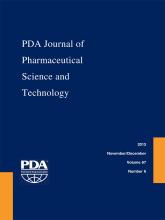Abstract
Part 1 of this three-part research series detailed the development and validation of a high-voltage leak detection test (HVLD, also known as an electrical conductivity and capacitance test) for verifying the container–closure integrity of a small-volume laminate plastic bag containing an aqueous solution formulation of the rapid-acting insulin analogue, insulin aspart (NovoRapid®/NovoLog®) by Novo Nordisk A/S, Bagsværd, Denmark. Leak detection capability was verified using positive controls each with a single laser-drilled hole in the bag film face. In this Part 2, HVLD leak detection capability was further explored in four separate studies. Study 1 investigated the ability of HVLD to detect weaknesses and/or gaps in the bag heat seal. Study 2 checked the HVLD detection of bag holes in packages stored 4 days at ambient conditions followed by 17 days at refrigeration. Study 3 examined HVLD test results for packages tested when cold. Study 4 compared HVLD test results as a function of bag plastic film lots. The final Part 3 of this series will report the impact of HVLD exposure on product visual appearance and chemical stability.
LAY ABSTRACT: In Part 1 of this three-part series, a leak test method based on electrical conductivity and capacitance, also called high-voltage leak detection (HVLD), was used to find leaks in small plastic bags filled with a solution for injection of the rapid-acting insulin analogue, insulin aspart (NovoRapid®/NovoLog®) by Novo Nordisk A/S, Bagsværd, Denmark. In this Part 2, HVLD leak detection capability was further explored in four separate studies. Study 1 investigated the ability of HVLD to detect bag heat seal leaks. Study 2 checked HVLD's ability to detect bag holes after a total of 21 days at ambient plus refrigerated temperatures. Study 3 looked to see if HVLD results changed for packages tested when still cold. Study 4 compared HVLD results for multiple bag plastic film lots. The final Part 3 of this series will report any evidence of drug component degradation caused by HVLD exposure.
- Container-closure
- Container-closure integrity
- Defects
- Electrical conductivity and capacitance leak detection
- Form-fill-seal packages
- High-voltage leak detection
- HVLD
- Leak
- Leakage
- Leak detection
- Leak test method
- Package
- Package defects
- Package integrity
- Package integrity method
- Plastic laminate bag
- Protein product
- Stability
- Insulin.
- © PDA, Inc. 2013
PDA members receive access to all articles published in the current year and previous volume year. Institutional subscribers received access to all content. Log in below to receive access to this article if you are either of these.
If you are neither or you are a PDA member trying to access an article outside of your membership license, then you must purchase access to this article (below). If you do not have a username or password for JPST, you will be required to create an account prior to purchasing.
Full issue PDFs are for PDA members only.
Note to pda.org users
The PDA and PDA bookstore websites (www.pda.org and www.pda.org/bookstore) are separate websites from the PDA JPST website. When you first join PDA, your initial UserID and Password are sent to HighWirePress to create your PDA JPST account. Subsequent UserrID and Password changes required at the PDA websites will not pass on to PDA JPST and vice versa. If you forget your PDA JPST UserID and/or Password, you can request help to retrieve UserID and reset Password below.






